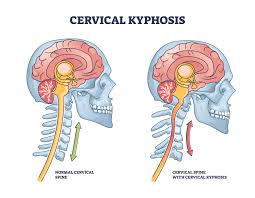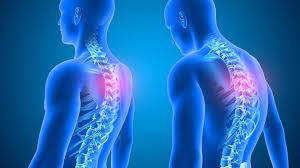

Cervical kyphosis is more than just a neck issue—it sets off a chain reaction that affects your entire upper body.
When the natural curve of the cervical spine is disrupted, it throws the body out of alignment, often leading to uneven or imbalanced shoulders.
This condition can quietly wreak havoc, creating tension, discomfort, and even pain that doesn’t always seem connected to the neck at first glance.
Many people dealing with shoulder misalignment or stiffness do not realize the root cause could be hiding in their spine.
Understanding the link between cervical kyphosis and shoulder imbalance is not only enlightening but empowering—it offers a clearer path toward relief and realignment.
If you have been puzzled by persistent upper body discomfort, the spine might just hold the answers.
Article Index
- What is cervical kyphosis?
- How cervical spine curvature affects shoulder symmetry
- Muscle chain reaction caused by forward neck posture
- Why nerve impingement contributes to shoulder dysfunction
- How altered biomechanics lead to asymmetrical shoulder loading
- Role of trapezius and scapular imbalance
- How cervical kyphosis impacts shoulder blade stability
- Conclusion
What is cervical kyphosis?
Cervical kyphosis refers to an abnormal forward curvature of the cervical spine (neck region).
Unlike the normal inward curve known as lordosis, kyphosis causes the neck to curve outward, pushing the head forward and altering overall posture.
This condition can arise from poor ergonomics (e.g., prolonged computer use or smartphone posture), degenerative disc disease, trauma, or congenital deformities.
While the visual signs—such as a hunched neck or forward head posture—are often noticeable, the biomechanical consequences can be far more complex. One common result is shoulder imbalance, as the body compensates for the shifted center of gravity.
This misalignment can lead to muscle strain, restricted range of motion, and even chronic shoulder pain. For example, a 2020 study in Spine Deformity found that cervical spine abnormalities often correlate with scapular asymmetry and shoulder dysfunction. Understanding this connection is crucial for proper diagnosis and treatment of upper body discomfort rooted in spinal issues.
How Cervical Spine Curvature affects Shoulder Symmetry?
The spine and shoulders function as an integrated unit, relying on structural harmony to maintain posture and movement.
When the cervical spine curves abnormally—as seen in cervical kyphosis—the head naturally shifts forward. This forward head posture disrupts the spine’s alignment, prompting a chain of compensations that begin in the thoracic spine and extend to the shoulder girdle.
As the body tries to maintain balance, the mechanics of the shoulder complex are altered. The clavicles (collarbones) and scapulae (shoulder blades) are pulled into unnatural resting positions.
Over time, Cervical kyphosis results in asymmetrical shoulder muscle tension, especially in the trapezius, levator scapulae, and rhomboid muscles.
These imbalances can cause one shoulder to appear higher, more forward, or more rotated than the other—a phenomenon commonly described as “shoulder drooping on one side.” This visible distortion is not just cosmetic; it is a key clinical sign often associated with underlying cervical kyphosis and musculoskeletal dysfunction.
Muscle Chain Reaction caused by Forward Neck Posture
Cervical kyphosis sets off a domino effect across the body’s interconnected myofascial chains.
As the head shifts forward from its neutral position, the body must recruit additional muscular support to keep it upright. This increased demand primarily affects the neck, upper back, and shoulders.
Muscles like the sternocleidomastoid and levator scapulae become overactive and tight, while the deep cervical flexors and other stabilizing muscles weaken from underuse. This imbalance disrupts normal movement patterns and posture.
To compensate, the upper trapezius and rhomboid muscles begin to work harder, often unevenly. One side may become dominant and tight, while the other remains underactive and weak.
This results in visible and functional shoulder asymmetry, with one shoulder appearing higher, more rotated, or restricted in movement.
These adaptations are not only uncomfortable but can also lead to chronic pain and limited mobility. The phrase “muscular imbalance in cervical spine and shoulders” captures this complex interplay perfectly.
Why Nerve Impingement contributes to Shoulder Dysfunction?
Another often overlooked consequence of cervical kyphosis is nerve compression.
As the cervical spine curves abnormally forward, it can cause a narrowing of the intervertebral foramen—the small openings through which spinal nerves exit.
This condition, known as foraminal stenosis, is a common companion to cervical kyphosis. When nerves exiting the cervical spine, particularly from the C5 to C7 levels, become compressed, it can lead to significant neuromuscular symptoms.
These nerves are responsible for motor control and sensation in key upper body muscles such as the deltoid, biceps, and those stabilizing the scapula.
Compression in these areas can result in one-sided shoulder pain, numbness, tingling, or even muscle weakness, all of which can contribute to postural asymmetry and shoulder imbalance.
This kind of neurological involvement is a critical component in understanding the full impact of cervical spine deformities. The phrase “cervical kyphosis causing nerve impingement in shoulders” effectively summarizes this often-missed mechanism.
How Altered Biomechanics lead to Asymmetrical Shoulder Loading?
Cervical kyphosis significantly alters the way mechanical forces are distributed throughout the upper body. In a healthy spine, proper alignment ensures that weight and motion are evenly dispersed across the joints and muscles.
However, when the cervical spine develops a kyphotic curve, this balance is disrupted. The head shifts forward, increasing strain on the neck and shoulder complex.
As a result, load-bearing becomes asymmetrical—even during everyday activities like carrying a bag, typing, or lifting an arm. These movements, which rely on a stable and aligned spine, become skewed due to the unstable base created by cervical kyphosis.
Over time, repeated micro-strains accumulate in specific muscle groups and joints, particularly in the shoulders. This chronic, uneven loading leads to muscular fatigue, joint stress, and noticeable postural changes.
The condition often manifests as “asymmetrical shoulder alignment due to cervical spine curve,” a term that perfectly encapsulates the biomechanical consequences of this spinal deformity.
Role of Trapezius and Scapular Imbalance
The trapezius muscle—think of it as your shoulders’ backstage manager—covers the neck, shoulders, and upper back, quietly keeping everything in line.
But when cervical kyphosis enters the scene, it throws off this well-rehearsed performance. With the head leaning forward like it is trying to read your phone screen from across the room, the upper traps jump into overdrive, working overtime to support the shifted weight.
Meanwhile, the middle and lower traps—responsible for pulling the shoulder blades down and back like a proud posture coach—get lazy and underused.
The result? Scapulae that hike up, rotate out, or even wing away from the body like rebellious dancers.
This imbalance does not just look awkward—it throws shoulder mechanics into disarray and can even cause pain.
The term “trapezius muscle imbalance from poor neck posture” sums it up nicely, but let’s be honest: it’s your posture’s way of throwing a trapezius tantrum.
How Cervical Kyphosis impacts Shoulder Blade Stability?
- The shoulder blades (scapulae) rely heavily on surrounding muscles in the neck and upper back to maintain proper positioning and stability during movement.
- Cervical kyphosis, characterized by a forward head posture and abnormal cervical curvature, disrupts this balance by altering muscular tension and alignment.
- Key scapular stabilizers—such as the serratus anterior, lower trapezius, and rhomboids—become overstretched and weakened due to the head’s forward displacement.
- When these muscles lose their ability to anchor the scapula effectively, the shoulder blade becomes unstable, especially during overhead or pushing movements.
- This instability often presents clinically as scapular winging (where the shoulder blade lifts off the rib cage) or scapular dyskinesis (abnormal motion of the scapula during arm movement).
- Such dysfunctions may lead to shoulder pain, limited range of motion, and decreased athletic performance.
- Collectively, these issues are now commonly grouped under the term “scapular instability linked to cervical spine issues”, reflecting growing recognition in clinical and sports medicine.
Conclusion
Cervical kyphosis is far more than a neck problem—it is a catalyst for widespread dysfunction throughout the upper body.
By distorting spinal alignment, it throws off the body’s structural harmony, leading to muscular imbalances, nerve compression, and disrupted biomechanics.
The result? Chronic shoulder imbalance, scapular instability, and even long-term pain or functional limitations.
These are not isolated symptoms—they are part of a bigger picture that starts at the cervical spine and radiates outward.
Ignoring this chain reaction means missing the root cause. That is why recognizing these interconnected patterns is not just helpful—it is essential.
For clinicians, it offers a roadmap to more effective, root-cause-driven treatment. For patients, it brings clarity and validation to symptoms that often feel mysterious or misdiagnosed.
Understanding the “how” and “why” of cervical kyphosis empowers both parties to break the cycle of compensation and pain. When it comes to shoulder asymmetry, the spine might just be the missing piece.
References:


